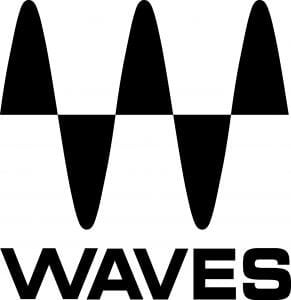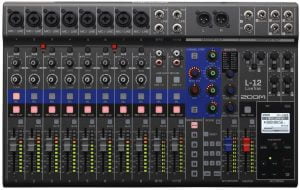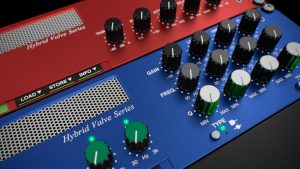 There are a lot of ways to tweak and process an audio project. EQ, compression, and filters are just some of the tools producers use to improve or alter the overall sound of a mix. One tool that’s been a mainstay for decades in many recording studios is the aural exciter. Aural exciters are used most often to accentuate certain low or high-end frequencies that tend to really catch the human ear. Aural exciters are commonly used towards the end of a signal processing chain to bring the extra clarity and oomph that producers often employ to get the attention of listeners.
There are a lot of ways to tweak and process an audio project. EQ, compression, and filters are just some of the tools producers use to improve or alter the overall sound of a mix. One tool that’s been a mainstay for decades in many recording studios is the aural exciter. Aural exciters are used most often to accentuate certain low or high-end frequencies that tend to really catch the human ear. Aural exciters are commonly used towards the end of a signal processing chain to bring the extra clarity and oomph that producers often employ to get the attention of listeners.
Like many things in the audio production universe, there are lots of aural exciters on the market, ranging from under a hundred bucks in price to thousands of dollars per unit. And while it can be good to have a hardware aural exciter in some settings, it’s often just as good to have the software equivalent. That’s what Waves has done with its Aphex Vintage Aural Exciter:
A true groundbreaker, the original Aural Exciter was highly regarded for its ability to increase and enhance presence, brightness, and vibrancy on vocal and instrumental tracks alike. It was even credited as a ‘session player’ on best-selling albums by the likes of Jackson Browne, Linda Ronstadt and James Taylor, engineered by Val Garay, who worked closely with us on the development of the plugin.
The Aphex Vintage Aural Exciter Plugin is on sale now. It normally retails for $299 but is available for a limited time at the massively reduced price of just $59. Learn more, and purchase the plugin thru the link above.

 Recording a multitrack live session, monitoring that session, and mixing it usually requires a bunch of different pieces of gear to get the job done. That’s certainly nothing new and it’s not even that bad if you’ve got a dedicated studio space available when you need it. But it’s not always possible to get access to that perfect combination of dedicated recording space stocked with the right equipment. In those cases, clever producers rely on creative improvisations that might be good enough. But it never hurts, especially in these instances, to be able to simplify things as much as possible.
Recording a multitrack live session, monitoring that session, and mixing it usually requires a bunch of different pieces of gear to get the job done. That’s certainly nothing new and it’s not even that bad if you’ve got a dedicated studio space available when you need it. But it’s not always possible to get access to that perfect combination of dedicated recording space stocked with the right equipment. In those cases, clever producers rely on creative improvisations that might be good enough. But it never hurts, especially in these instances, to be able to simplify things as much as possible. If you’re into audio production (and we’re guessing that if you follow this blog, you probably are), then you love plugins. And the only thing better than the plugins you have now, is getting more plugins. Because then, you have more plugins. And as we covered above, you’re an audio producer. Who loves plugins.
If you’re into audio production (and we’re guessing that if you follow this blog, you probably are), then you love plugins. And the only thing better than the plugins you have now, is getting more plugins. Because then, you have more plugins. And as we covered above, you’re an audio producer. Who loves plugins. You can never have enough digital audio workstations. But it can be expensive to buy more than one. That’s why it’s great when a new DAW hits the market for the super low price of FREE.
You can never have enough digital audio workstations. But it can be expensive to buy more than one. That’s why it’s great when a new DAW hits the market for the super low price of FREE. The rise of digital audio production tools has forever changed the landscape of the medium. It might be fun to wax nostalgic over the recording studios of the past, with their rooms of big, bulky gear that looked really cool on photographs inside of a record sleeve. But for all their glory, those studios weren’t accessible to most. You had to be well connected and flush with cash to gain entrance. And while today it’s easier than ever to produce high quality audio with nothing more than a laptop, one thing that many producers long for is that “warm valve” tone that came naturally with all of that big, bulky gear.
The rise of digital audio production tools has forever changed the landscape of the medium. It might be fun to wax nostalgic over the recording studios of the past, with their rooms of big, bulky gear that looked really cool on photographs inside of a record sleeve. But for all their glory, those studios weren’t accessible to most. You had to be well connected and flush with cash to gain entrance. And while today it’s easier than ever to produce high quality audio with nothing more than a laptop, one thing that many producers long for is that “warm valve” tone that came naturally with all of that big, bulky gear. When it comes to the audio production process, it’s easy to get obsessed with things like sound treatments, microphones, processors, mixers, and monitors. While those can all be important components of any session, one thing that’s easy to overlook is the headphone amp.
When it comes to the audio production process, it’s easy to get obsessed with things like sound treatments, microphones, processors, mixers, and monitors. While those can all be important components of any session, one thing that’s easy to overlook is the headphone amp. Audio producers usually have a large library of digital samples. But how many times can you hear that same set of sampled drum or bass loops before they start getting stale? One way to breathe new life into those old samples is to manipulate them into something that sounds entirely different. That’s exactly what Accusonus is doing with
Audio producers usually have a large library of digital samples. But how many times can you hear that same set of sampled drum or bass loops before they start getting stale? One way to breathe new life into those old samples is to manipulate them into something that sounds entirely different. That’s exactly what Accusonus is doing with  It’s easier than ever to work on complex audio projects from almost any location. But doing so may still require producers to have to haul around bulky accessories like hard drives, with all of their attendant parts and cables, in order to work in a remote location. At this point in history, we’ve grown accustomed to storing everything from spreadsheets to our personal photo libraries in the cloud. So why not also do the same thing with our audio projects?
It’s easier than ever to work on complex audio projects from almost any location. But doing so may still require producers to have to haul around bulky accessories like hard drives, with all of their attendant parts and cables, in order to work in a remote location. At this point in history, we’ve grown accustomed to storing everything from spreadsheets to our personal photo libraries in the cloud. So why not also do the same thing with our audio projects?